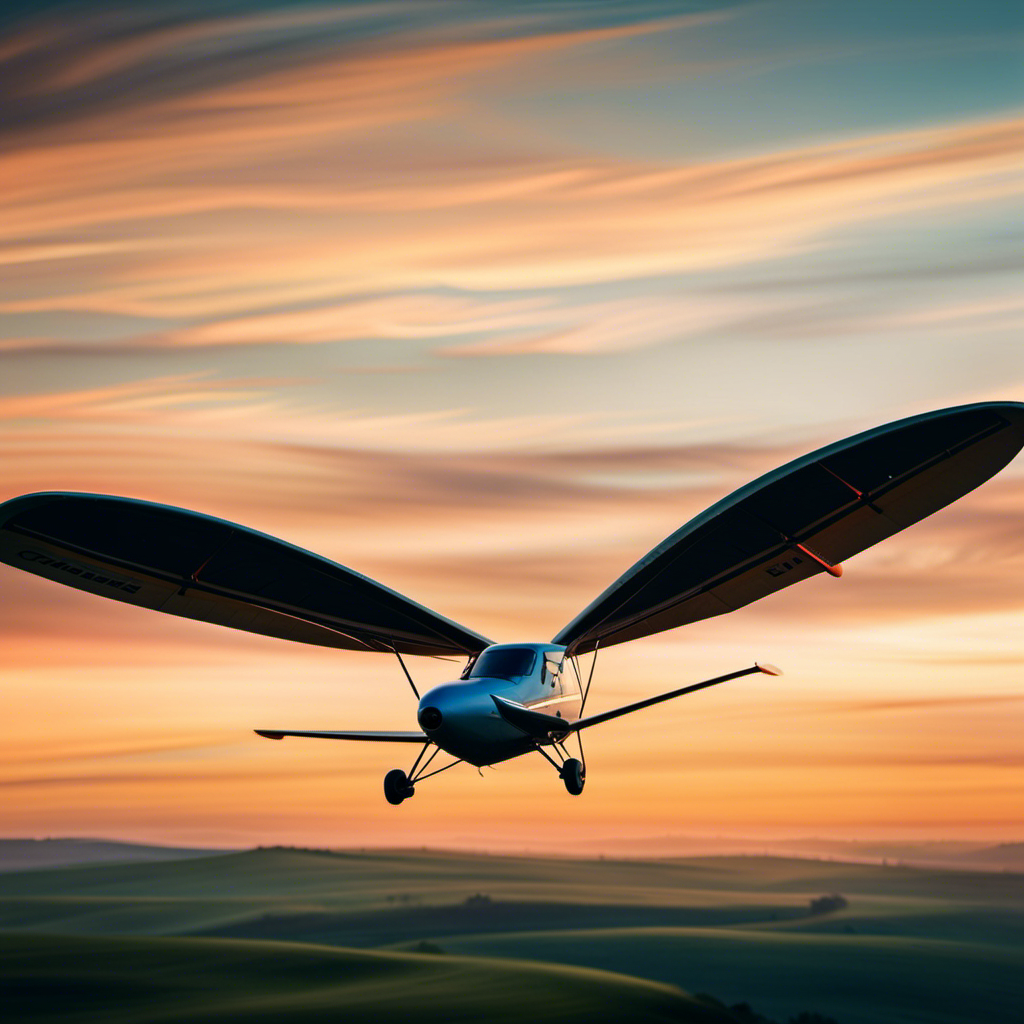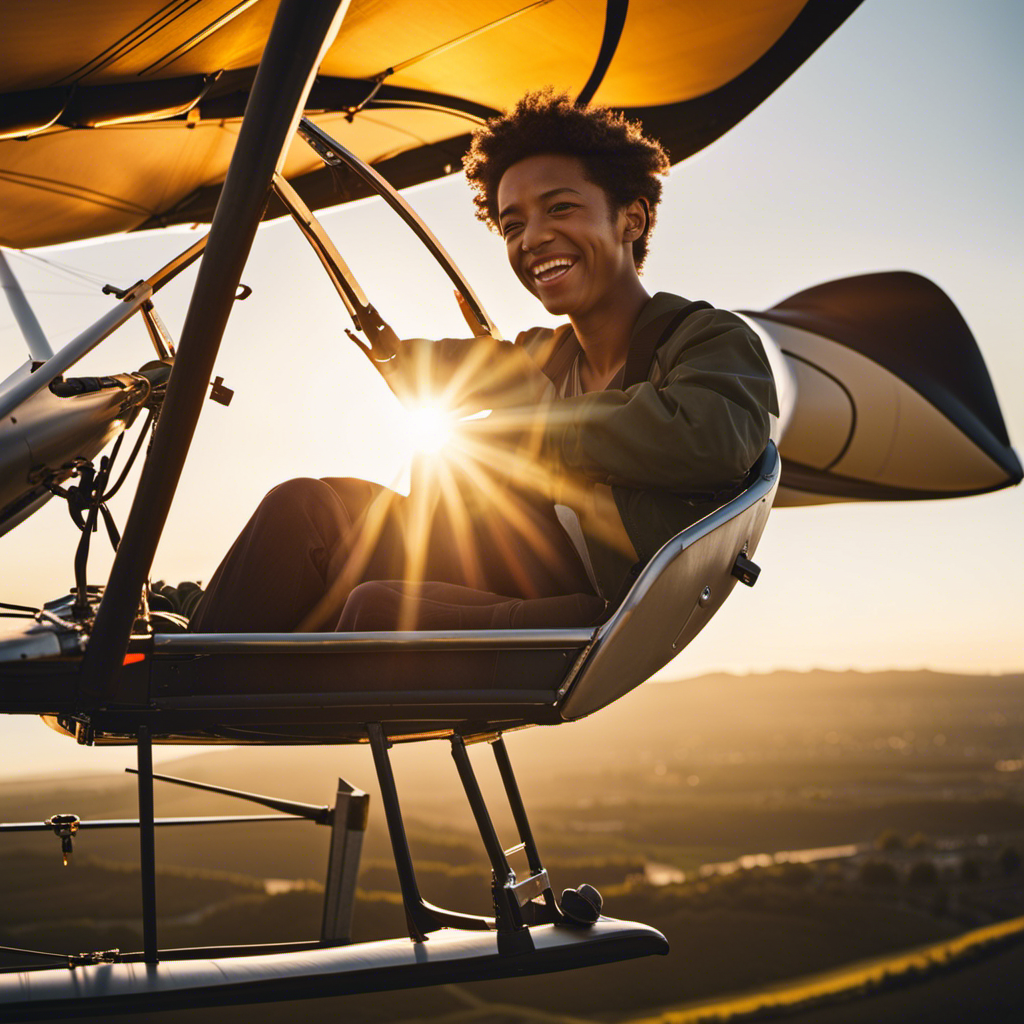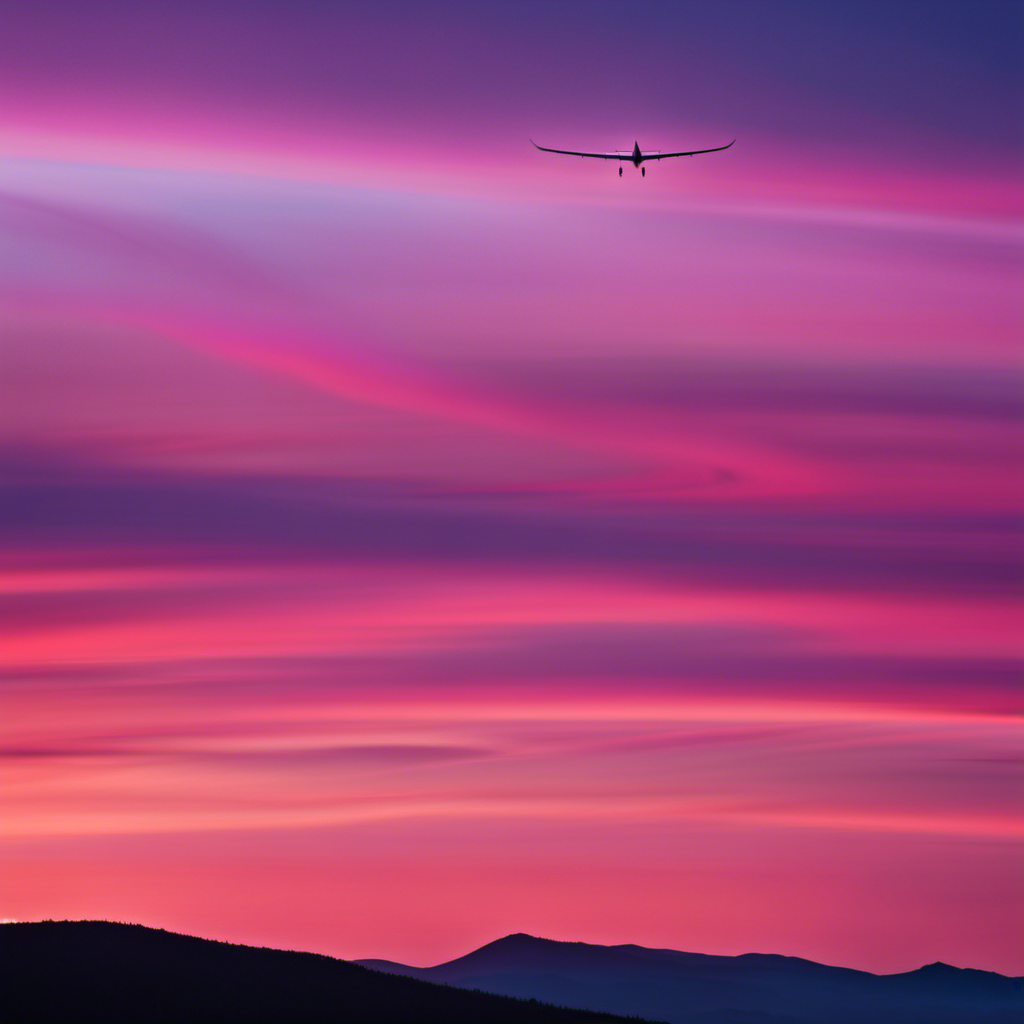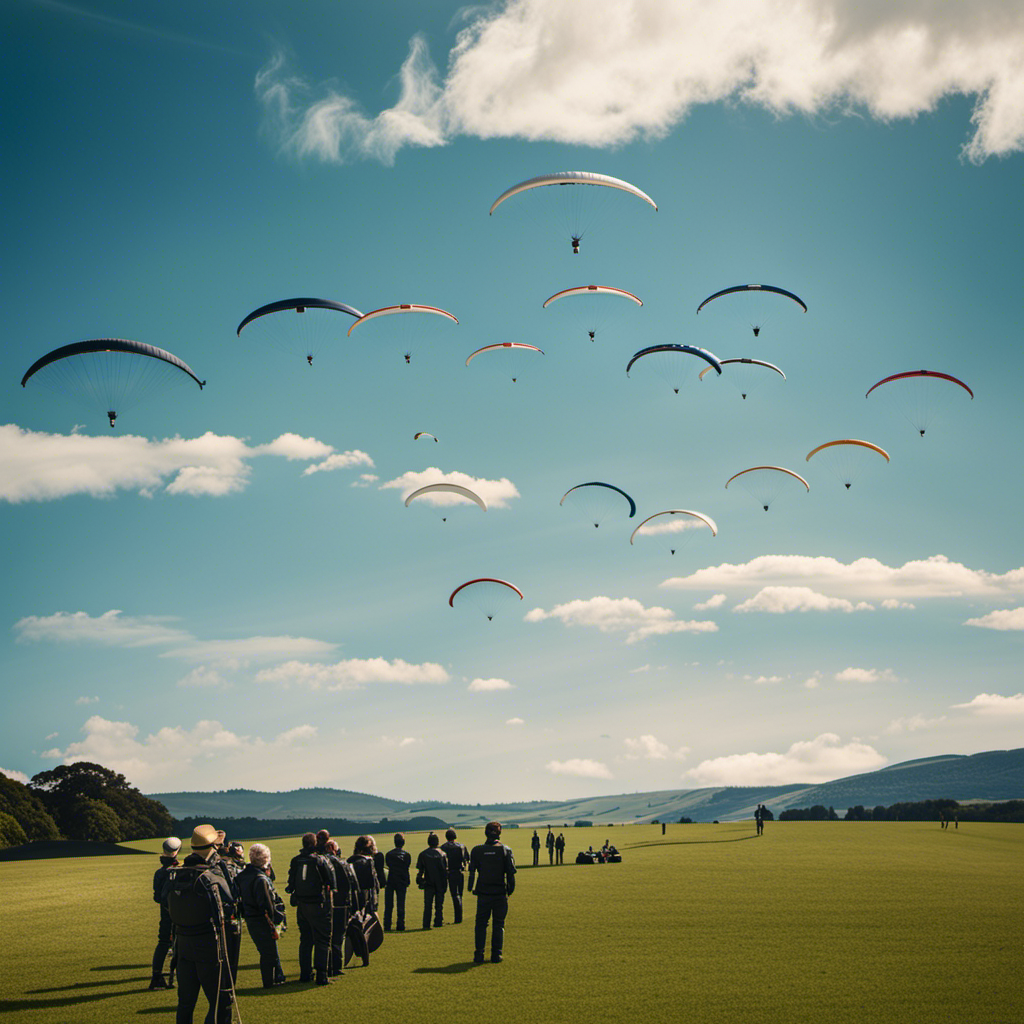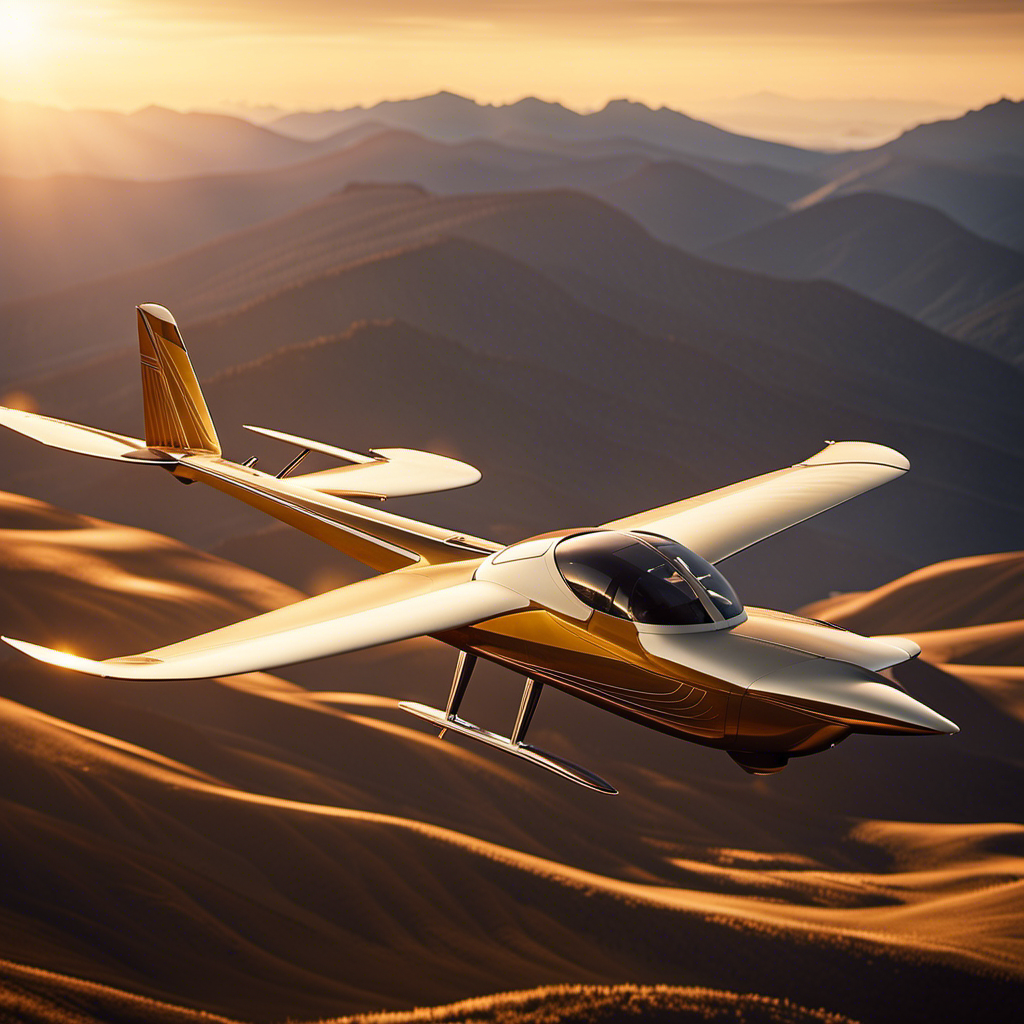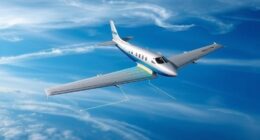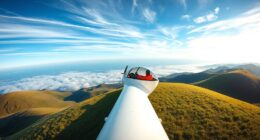Are you eager to experience the excitement of flying a glider high in the sky? You’ve come to the right place.
In this article, I’ll be your guide as we delve into the intricate world of glider flight. We’ll cover everything from the basics of launching and landing to the advanced techniques of thermalling and soaring.
And don’t worry, I’ll also share some essential safety tips and maintenance know-how to ensure your gliding adventures are smooth and enjoyable.
So buckle up, my friend, and get ready to soar like never before.
Key Takeaways
- Recognize favorable weather patterns and potential hazards
- Master gliding techniques such as thermal soaring and ridge soaring
- Learn and practice safety and emergency procedures
- Prioritize glider maintenance and care for optimal performance and safety
Introduction to Glider Piloting
Before we dive into the details of glider piloting, let’s start with a brief introduction to what it entails.
As a glider pilot, mastering glider flying techniques is essential. This involves understanding how to control the glider’s flight path without the reliance on an engine. Glider flying techniques include learning how to soar, which is the art of using rising air currents to gain altitude and stay aloft.
In addition to the techniques, glider piloting also requires the use of specific equipment. Glider pilots rely on instruments such as variometers, altimeters, and airspeed indicators to monitor and navigate their flights. These tools help us maintain situational awareness and make informed decisions during our flights.
Now that we have a basic understanding of glider piloting techniques and equipment, let’s move on to understanding the basics of glider flight.
Understanding the Basics of Glider Flight
Understanding the basics of glider flight involves knowing how to manipulate the control surfaces. As a glider pilot, I rely on my understanding of glider aerodynamics and the use of glider flight instruments to ensure a safe and efficient flight. Here are three key points to consider:
-
Control Surfaces: The glider is equipped with control surfaces, including the ailerons, elevator, and rudder, which allow me to control the roll, pitch, and yaw of the aircraft respectively.
-
Glider Aerodynamics: By understanding the principles of lift, drag, and weight, I can make adjustments to the control surfaces to maintain the desired flight path and optimize the glider’s performance.
-
Glider Flight Instruments: Instruments such as the variometer, altimeter, and airspeed indicator provide vital information about the glider’s altitude, vertical speed, and airspeed, enabling me to make informed decisions during the flight.
With a solid grasp of these fundamentals, I can now move on to the next step of becoming a glider pilot: finding a gliding club where I can receive proper training and gain practical experience.
Getting Started: Finding a Gliding Club
When it comes to joining a gliding club, there are a few key points to consider.
First and foremost, it is important to find a club that aligns with your goals and interests as a glider pilot.
Additionally, understanding the training and certification requirements associated with joining a gliding club is crucial in order to ensure a safe and successful experience in the world of gliding.
Joining a Gliding Club
Joining a gliding club is a great way to learn how to be a glider pilot. As someone who has gone through the joining process myself, I can attest to the numerous benefits of joining a gliding club. Here are four reasons why joining a gliding club is worth considering:
-
Mentorship and Guidance: Gliding clubs provide access to experienced pilots who are eager to share their knowledge and guide you through the learning process.
-
Community and Camaraderie: Being part of a gliding club means joining a community of like-minded individuals who share your passion for flying. The friendships and camaraderie that develop within the club are invaluable.
-
Access to Resources: Gliding clubs offer access to gliders, training materials, and facilities that are essential for your journey to becoming a pilot.
-
Cost-Effective Training: Joining a gliding club often offers a more affordable way to learn how to fly compared to other aviation options.
By joining a gliding club, you will gain access to a wealth of resources and guidance that will support you in your journey towards becoming a glider pilot.
Transitioning into the subsequent section about ‘training and certification requirements,’ it is important to understand the necessary steps to obtain the required training and certification.
Training and Certification Requirements
To begin your journey towards becoming a certified glider pilot, you’ll need to familiarize yourself with the training and certification requirements. As an experienced glider pilot, I can guide you through this process.
The first step is to gather the necessary training resources. There are various books, online courses, and instructional videos available that cover everything from aerodynamics to emergency procedures.
Once you have the theoretical knowledge, it’s time to gain practical flying experience. Most gliding clubs offer training programs where you can learn the fundamentals under the guidance of experienced instructors. These programs typically include ground school lessons, simulator sessions, and actual flights.
It’s important to log enough hours and demonstrate proficiency in different maneuvers before you can pursue certification. With the right training and experience, you’ll be well-prepared to learn the crucial skills of launching and landing, which we’ll explore in the next section.
Learning to Launch and Land
You’ll need to practice your timing and coordination in order to smoothly launch and land the glider. Learning these techniques is crucial for a glider pilot, as they form the foundation of safe flying.
Safety procedures are of utmost importance during takeoffs and landings, as these are the most critical phases of flight. When launching, you must ensure that the glider is aligned with the wind direction and that the tow line is properly connected. As you gain experience, you’ll learn to judge the correct moment to release the tow line and begin your solo flight.
Similarly, landing requires precise control of the glider’s speed and descent rate, along with accurate timing to touch down smoothly. Mastering the art of launching and landing sets the stage for mastering thermalling and soaring techniques, where pilots harness rising air currents to gain altitude and extend their flight time.
Mastering Thermalling and Soaring Techniques
Once you’ve mastered thermalling and soaring techniques, you’ll be able to extend your flight time by harnessing rising air currents. Here are three key strategies to help you become proficient in thermalling and soaring:
-
Reading the sky: Develop the ability to interpret the subtle clues that indicate the presence of thermals. Look for cumulus clouds, birds circling, or even the movement of leaves on the ground. These signs can guide you towards areas of lift.
-
Centering thermals: Once you’ve found a thermal, it’s essential to stay within its core to gain maximum altitude. Practice making smooth, coordinated turns to remain in the strongest part of the thermal.
-
Using ridge lift: In addition to thermals, ridge lift can also help you stay aloft. By flying close to ridges or cliffs, you can take advantage of the wind deflection to generate lift.
Understanding Weather Conditions for Gliding
When it comes to gliding, understanding weather conditions is crucial for a safe and successful flight.
As an experienced glider pilot, I have learned the importance of recognizing favorable weather patterns and identifying potential hazards.
Recognizing Favorable Weather Patterns
To recognize favorable weather patterns for glider flying, it’s important to keep an eye on cloud formations and wind directions. As an experienced glider pilot, I have learned to rely on these key indicators to determine whether the conditions are suitable for a safe and enjoyable flight.
When it comes to cloud formations, I look for cumulus clouds, which indicate rising air currents that can provide the necessary lift for gliding. Additionally, I pay close attention to the wind patterns. A steady and consistent wind direction is ideal for gliding, as it allows for predictable flight paths and smooth flying.
Identifying Potential Hazards
By analyzing cloud formations and wind patterns, I can accurately assess whether there are potential hazards that could impact my flight. As a glider pilot, hazards identification is crucial to ensure the safety of my journey. I rely on my knowledge and experience to recognize signs of danger and take appropriate safety measures. To help you understand the hazards I look out for, here is a table outlining some common hazards and the safety measures I take to mitigate them:
| Hazard | Safety Measure |
|---|---|
| Thunderstorms | Avoid flying near thunderstorm cells |
| Strong crosswinds | Adjust flight path and maintain control |
| Turbulence | Maintain a safe altitude and slow down if necessary |
| Wind shear | Be vigilant during takeoff and landing |
| Poor visibility | Use instruments and rely on radio communication |
With these safety measures in mind, I can navigate through potential hazards and ensure a safe flight. Now, let’s delve into the advanced gliding techniques that enhance my flying skills.
Advanced Gliding Techniques
You can improve your gliding skills by implementing advanced techniques such as thermal soaring and ridge soaring. These techniques are commonly used in competition gliding and require precision and expertise. Here are four advanced gliding maneuvers and competition gliding techniques that can take your skills to the next level:
-
Dynamic soaring: This technique involves utilizing the vertical wind gradient to gain speed and altitude by flying close to the ground.
-
Speed-to-fly: By calculating the optimal speed based on the glider’s polar curve and the current atmospheric conditions, pilots can maximize their efficiency and speed.
-
Energy management: Skilled glider pilots know how to efficiently use the available energy sources, such as thermals and ridge lift, to stay airborne for extended periods.
-
Racing tactics: In competition gliding, strategic decision-making and navigation skills play a crucial role. Pilots must choose the best routes, exploit advantageous weather conditions, and make timely decisions to outperform their competitors.
Mastering these advanced techniques will greatly enhance your gliding abilities. However, it is equally important to be well-versed in safety and emergency procedures to ensure a safe and enjoyable flight.
Safety and Emergency Procedures
In the event of an emergency, it’s important for all individuals involved in gliding to be familiar with safety procedures. As an experienced glider pilot, I understand the criticality of being prepared for unexpected situations.
One of the most crucial emergency procedures is the emergency landing. When faced with an emergency, it is essential to quickly assess the situation, select a suitable landing spot, and execute a controlled descent.
Additionally, being knowledgeable about first aid procedures is vital. In the event of an injury, immediate action can make all the difference. As a glider pilot, I am trained in basic first aid techniques, such as treating minor cuts, stabilizing fractures, and performing CPR if necessary.
Now, let’s transition into the subsequent section about glider maintenance and care, ensuring the longevity and safety of our aircraft.
Glider Maintenance and Care
As a glider pilot, safety is of utmost importance. After understanding safety and emergency procedures, it is crucial to focus on glider maintenance and care. By maintaining and caring for your glider properly, you ensure its optimal performance and extend its lifespan.
Here are some key points to consider:
- Regular cleaning and inspection of the glider’s surfaces and control mechanisms.
- Lubrication of moving parts to ensure smooth operation.
- Regular checks of the glider’s structural integrity and repairs as needed.
- Pre-flight checks to ensure all systems are functioning correctly, including control surfaces, instruments, and emergency equipment.
By following these maintenance practices, you can confidently take to the skies knowing that your glider is in top condition.
Now, let’s discuss the importance of continuing education and advancing your skills as a glider pilot.
Continuing Education and Advancing Your Skills
Continuing your education and advancing your skills as a glider pilot is essential for staying up to date with the latest techniques and safety practices.
As a glider pilot, I understand the importance of continuous learning and skill development in this field. Glider piloting is a complex and ever-evolving discipline, and staying ahead requires a commitment to ongoing education.
By participating in advanced training courses and workshops, pilots can deepen their understanding of aerodynamics, meteorology, and navigation. These opportunities also provide a platform for honing practical skills, such as precision landings and emergency procedures.
Additionally, staying connected with fellow pilots and engaging in knowledge-sharing forums can expose us to new ideas and perspectives.
With continuing education, we can ensure that we are equipped with the most up-to-date knowledge and skills to navigate the skies safely and effectively.
Frequently Asked Questions
How long does it take to become a certified glider pilot?
To become a certified glider pilot, the application process involves meeting glider pilot training requirements. This typically includes completing a certain number of flight hours, passing written and practical exams, and demonstrating proficiency in glider operations.
Are there any age restrictions for learning to fly gliders?
There are no age restrictions for learning to fly gliders. However, it is important to consider any potential fear of heights. With proper training and guidance, individuals of any age can become glider pilots.
Can I fly a glider if I have a fear of heights?
To fly a glider, it is possible to overcome fears of heights through mental preparation. By gradually exposing oneself to height-related activities and seeking support, one can develop the confidence needed to pilot a glider successfully.
Are there any weight restrictions for glider pilots?
Weight restrictions for glider pilots vary depending on the aircraft and regulations. It is important to meet the physical requirements, as gliding requires good coordination, strength, and stamina.
Can I fly a glider if I have a medical condition?
Yes, you can fly a glider if you have a medical condition. However, you may need to obtain a medical waiver before undergoing glider pilot training. This ensures that you are fit to fly safely.
Conclusion
In conclusion, becoming a glider pilot is a thrilling and rewarding journey. By immersing oneself in the world of gliding, one can learn the intricacies of flight and master the techniques needed to soar through the sky.
From understanding the basics to advancing to advanced techniques, the possibilities are endless. Remember, gliding is not just a hobby, it’s a passion that requires dedication and continuous learning.
So spread your wings and take to the skies, for the sky is the limit in the world of glider piloting.
